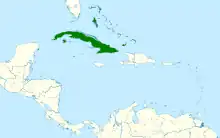| Western spindalis | |
|---|---|
_male.JPG.webp) | |
| Male Spindalis zena pretrei Viñales, Cuba | |
 | |
| Female Spindalis zena pretrei Ciego de Ávila, Cuba | |
| Scientific classification | |
| Domain: | Eukaryota |
| Kingdom: | Animalia |
| Phylum: | Chordata |
| Class: | Aves |
| Order: | Passeriformes |
| Family: | Spindalidae |
| Genus: | Spindalis |
| Species: | S. zena |
| Binomial name | |
| Spindalis zena | |
 | |
| Synonyms | |
|
Fringilla zena Linnaeus, 1758 | |
_male_2.JPG.webp)
showing feathers on back, Cuba
The western spindalis (Spindalis zena) is a songbird species. It was formerly considered conspecific with the other three species of spindalis, with the common name stripe-headed tanager.
Taxonomy
The spindalises were traditionally considered aberrant tanagers of the family Thraupidae, but like the equally enigmatic bananaquit (Coereba flaveola), they are formally treated as incertae sedis (place uncertain) among the nine-primaried oscines until the recognition of the family spindalidae.
Description
The male is brightly colored with a black and white horizontally striped head and contrasting burnt orange throat, breast and nape. The remainder of the belly is light grey. There are two color variations: green-backed (generally northern) and black-backed (generally northern).[2] The female has similar markings on the head, but washed out to a medium grey. She is olive-grey above and greyish-brown below, with a slight orange wash on the breast, rump, and shoulders.[3] They are 15 cm (5.9 in) long and weigh 21 g (0.74 oz).[2]
Distribution and habitat
The species is found in southeastern Florida and the western Caribbean (Cozumel, the Cayman Islands, Cuba, the Bahamas and the Turks and Caicos Islands). It is a rare visitor of extreme southern Florida, where the subspecies S. z. zena successfully bred in 2009.[4]
Its natural habitats are subtropical or tropical moist lowland forests, subtropical or tropical moist montane forest, and heavily degraded former forest. The subspecies zena is found in pine forest.
Conservation
It is not considered a threatened species by the IUCN.
Subspecies
- Spindalis zena zena: Central Bahamas
- Spindalis zena townsendi: Grand Bahama Island, the Abacos and Green Turtle Cay
- Spindalis zena pretrei: Cuba, Isle of Pines and adjacent offshore cays
- Spindalis zena salvini: Grand Cayman Island
- Spindalis zena benedicti: Cozumel Island
References
- ↑ BirdLife International (2020). "Spindalis zena". IUCN Red List of Threatened Species. 2020: e.T22722522A137033144. doi:10.2305/IUCN.UK.2021-3.RLTS.T22722522A137033144.en. Retrieved 12 November 2021.
- 1 2 Sibley, David Allen (2000). The Sibley Guide to Birds. New York: Knopf. p. 460. ISBN 0-679-45122-6.
- ↑ Garrido, Orlando H.; Kirkconnell, Arturo (2000). Field Guide to the Birds of Cuba. Ithaca, NY: Comstock, Cornell University Press. p. 205. ISBN 978-0-8014-8631-9.
- ↑ Manfredi, Larry. "Western Spindalis nesting, first U.S. record!". South Florida Birding.
External links
- BirdLife species factsheet for Spindalis zena
- "Spindalis zena". Avibase.
- "Western spindalis media". Internet Bird Collection.
- Western spindalis photo gallery at VIREO (Drexel University)
- Western spindalis species account at Neotropical Birds (Cornell Lab of Ornithology)
- Interactive range map of Spindalis zena at IUCN Red List maps
- Audio recordings of Western spindalis on Xeno-canto.
